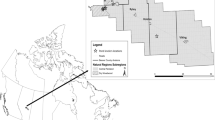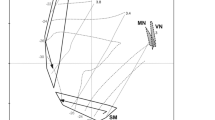Abstract
To assess whether raised bog restorationmeasures contribute to the conservation andrestoration of the fauna diversity,macroinvertebrate species assemblages werecompared between water bodies created byrewetting measures and water bodies whichhave not been subject to restorationmeasures, but are remnants offormer peat cuttings and trenches used forbuckwheat culture in the past.The restoration sites were inhabited bycharacteristic raised bog species and rarespecies, but their numbers were higher atthe remnant sites not affected byrestoration management. A considerablenumber of characteristic and rare faunaspecies were only found at the remnantsites. The remnant sites includedconsiderably more variation inmacroinvertebrate species assemblages andhad a higher cumulative species richness.The number of characteristicmacroinvertebrate species was not clearlyrelated to the presence of a characteristicraised bog vegetation. In restoration sitesnumbers of rare and characteristic speciesper site tended to increase with the timeelapsed after rewetting. However,restoration measures will not automaticallyresult in restoration of a more or lesscomplete macroinvertebrate speciesspectrum, as restoration measures have sofar resulted in habitats for only a limitednumber of the characteristic species.When planning restoration measures, it isrecommended to protect the populations ofrare and characteristic species present inthe area, as these populations may becomethe sources for colonization of rewettedsites. Safeguarding habitat diversityduring the restoration process andrestoration of different elements of thehabitat diversity of complete raised bogsystems will result in the characteristicfauna diversity being conserved andrestored more successfully.
Similar content being viewed by others
References
Akkermann, R. 1982. Möglichkeiten und Zielsetzungen für eine Regeneration von Hochmooren – zoologisch betrachtet. In: Akkermann, R. (ed.), Regeneration von Hochmooren. Informationen zu Naturschutz und Landschaftspflege in Nordwestdeutschland. Band 3. pp. 151–163.
Bal, D., Beije, H.M., Fellinger, M., Haveman, R., van Opstal, A.J.F.M. and van Zadelhoff, F.J. 2001. Handboek Natuurdoeltypen. Ministerie van Landbouw, Natuurbeheer en Visserij, Wageningen. 832 pp.
Biggs, J., Fox, G., Whitfield, M., Williams, P., Sear, D. and Bray, S. 2001. River restoration – Is it worth it? Freshw. Biol. Ass. Newsl. 14: 1–3.
Bobbink, R., Hornung, M. and Roelofs, J.G.M. 1998. The effects of air-borne nitrogen pollutants on species diversity in natural and semi-natural European vegetation. J. Ecol. 86: 717–738.
Bos, F. and Wasscher, M. 1997. Veldgids Libellen. KNNV, Utrecht. 256 pp.
Brundin, L. 1966. Transantarctic relationship and their significance, as evidenced by chironomid midges – with a monograph of the subfamilies Podonominae and Aphroteniinae and the Austral Heptagyiae. Kungliga Svenska Vetenskapsakademiens handlingar. Series 4, band 11. Stockholm. 472 pp.
Buttler, A., Warner, B.G., Grosvernier, P. and Matthey, Y. 1996. Vertical patterns of testate amoebae (Protozoa: Rhizopoda) and peat-forming vegetation on cutover bogs in the Jura, Switzerland. New Phytol. 134: 371–382.
Carpenter, J.H. 1965. The Chesapeake Bay Institute technique for the Winkler dissolved oxygen method. Limnol. & Oceanogr. 10: 141–143.
Den Boer, P.J. 1990. The survival value of dispersal in terrestrial arthropods. Biol. Conserv. 54: 175–192.
De Leeuw, J.P.M. 1986. Een Onderzoek naar het Voorkomen en de Verspreiding van Aquatische Macro-en Microfauna in de Ierse Hoogvenen, deel 1: Macrofauna. Doctoraalverslag 206, Aquatische Oecologie, Katholieke Universiteit Nijmegen. 75 pp.
De Vries, H.H. 1996. Viability of Ground Beetle Populations in Fragmented Heathlands. Biological Station Wijster, Wageningen Agricultural University. 133 pp. 458
Drew, E.A. and Robertson, A.A. 1974. A simple field version of the Winkler determination of dissolved oxygen. New Phytol. 73: 793–796.
Drost, M.B.P., Cuppen, H.P.J.J., van Nieukerken, E.J. and Schreijer, M. (eds.). 1992. De Waterkevers van Nederland. Uitgeverij KNNV, Utrecht. 280 pp.
Duursema, G. 1996. Vennen in Drenthe, een Onderzoek naar Ecologie en Natuur op Basis van Macrofauna. Zuiveringsschap Drenthe, Assen. 140 pp.
Fairchild, G.W., Faulds, A.M. and Matta, J.F. 2000. Beetle assemblages in ponds: effects of habitat and site age. Freshw. Biol. 44: 523–534.
Foster, G.N., Foster, A.P., Eyre, M.D. and Bilton, D.T. 1990. Classification of water beetle assemblages in arable fenland and ranking of sites in relation to conservation value. Freshw. Biol. 22: 343–354.
Geijskes, D.C. and Van Tol, J. 1983. De Libellen van Nederland. Koninklijke Nederlandse Natuurhistorische Vereniging, Hoogwoud. 368 pp.
Göttlich, K. 1980. Moor-und Torfkunde. E. Schweizerbart'sche Verlagsbuchhandlung Stuttgart. 338 pp.
Grasshoff, H. and Johanssen, H. 1977. A new sensitive method for determination of ammonia in seawater. Water Res. 2: 516.
Harper, D., Mekotova, J., Hulme, S., White, J. and Hall, J. 1997. Habitat heterogeneity and aquatic macroinvertebrate diversity in floodplain forests. Global Ecol. & Biogeogr. Lett. 6: 275–285.
Henriksen, A. 1965. An automated method for determining lowlevel concentrations of phosphate in fresh and saline waters. Analyst 90: 29–34.
Higler, L.W.G. 1995. Lijst van kokerjuffers (Trichoptera) in Nederland met opmerkingen over uitgestorven en bedreigde soorten. Entomol. Ber. 55: 149–156.
Irmler, U., Müller, K. and Eigner, J. 1998. Das Dosenmoor – Ökologie eines regenerierenden Hochmoores. Faunistisch-ökologische Arbeitsgemeinschaft, Kiel. 283 pp.
Kamphake, L.H., Hannah, S.H. and Cohen, J.M. 1967. Automated analysis for nitrate by hydrazine reduction. Water Res. 1: 206.
König, A. 1992. Die Libellenfauna im Abbaugebiet Haidauer Ried des Wurzacher Riedes. Telma 22: 109–122.
Lamers, L.P.M., Farhoush, C., van Groenendael, J.M. and Roelofs, J.G.M. 1999. Calcareous groundwater raises bogs; the concept of ombrotrophy revisited. J. Ecol. 87: 639–648.
Lamers, L.P.M., Tomassen, H.B.M. and Roelofs, J.G.M. 1998a. Sulfate-induced eutrophication and phytotoxicity in freshwater wetlands. Envir. Sci. & Technol. 32: 199–205.
Lamers, L.P.M., van Roozendaal, S.M.E. and Roelofs, J.G.M. 1998b. Acidification of freshwater wetlands: combined effects of non-airborne sulfur pollution and desiccation. Water, Air & Soil Poll. 105: 95–106.
Leuven, R.S.E.W., van der Velden, J.A., Vanhemelrijk, J.A.M. and van der Velde, G. 1987a. Impact of acidification on chironomid communities in poorly buffered waters in The Netherlands. Entomologica scandinavica Supplements 29: 269–280.
Leuven, R.S.E.W., Vanhemelrijk, J.A.M. and van der Velde, G. 1987b. The distribution of Trichoptera in Dutch soft waters differing in pH. In: Bournaud, M. and H. Tachet (eds.), Proc. 5th Int. Symp. on Trichoptera. Junk Publishers, Dordrecht, pp. 359–365.
McAleece, N. 1997. Biodiversity Professional Beta 1. The Natural History Museum, London and The Scottish Association for Marine Science, UK.
Mossakowski, D. and Främbs, H. 1993. Carabiden als Indikatoren der Auswirkungen von Wiedervernässerungsmassnahmen auf die Fauna im Leegmoor. Natursch. Landschaftspfl. Nieders. 29: 79–114.
Nieser, N. 1982. De Nederlandse water-en oppervlaktewantsen (Heteroptera: Nepomorpha en Gerromorpha). Wetensch. Med. K.N.N.V. 155: 1–103.
Nijboer, R.C. and Verdonschot, P.F.M. (eds.). 2001. Zeldzaamheid van de Macrofauna van de Nederlandse Binnenwateren. Werkgroep Ecologisch Waterbeheer, themanummer 19. 77 pp.
RIVM. 2001. Natuurbalans 2001. Kluwer, Alphen aan den Rijn. 189 pp.
O'Brien, J. 1962. Automatic analysis of chlorides in sewage wastes. Engineering 33: 670–672.
Oertli, B., Auderset Joye, D., Castella, E., Juge, R., Cambin, D. and Lachavanne, J.-B. 2002. Does size matter? The relationship between pond area and biodiversity. Biol. Conserv. 104: 59–70.
Painter, D. 1999. Macroinvertebrate distributions and the conservation value of aquatic Coleoptera, Mollusca and Odonata in the ditches of traditionally managed and grazing fen at Wicken fen, UK. J. Appl. Ecol. 36: 33–48.
Peus, F. 1923. Die Tierwelt der Moore. Handbuch der Moorkunde III. Bornträger verlag, Berlin. 277 pp.
Schouten, M.G.C., Schouwenaars, J.M., Esselink, H., Lamers, L.P.M. and van der Molen, P.C. 1998. Hoogveenherstel in Nederland – droom en werkelijkheid. In: Bobbink, R., Roelofs, J.G.M. and Tomassen, H.B.M. (eds.), Effectgerichte Maatregelen en Behoud Biodiversiteit in Nederland. pp. 93–113. Symposiumverslag. Aquatische Oecologie en Milieubiologie, Katholieke Universiteit Nijmegen.
Schouwenaars, J.M., Esselink, H., Lamers, L.P.M. and van der Molen, P.C. 2002. Ontwikkelingen en Herstel van Hoogveensystemen – Bestaande Kennis en Benodigd Onderzoek. Expertisecentrum LNV, Wageningen. 188 pp.
Settele, J., Margules, C., Poschlod, P. and Henle, K. (eds.). 1996. Species Survival in Fragmented Landscapes. Kluwer, Dordrecht. 381 pp.
Smit, H. and van der Hammen, H. 2000. Atlas van de Nederlandse watermijten (Acari: Hydrachnidia). Ned. Faun. Med. 13: 1–272.
Smits, M.J.A., van Duinen, G.A., Bosman, J.G., Brock, A.M.T., Javois, J., Kuper, J.T., Peeters, T.M.J., Peeters, M.A.J. and Esselink, H. 2002. Species richness in a species poor system: aquatic macroinvertebrates of Nigula raba, an intact raised bog system in Estonia. Proc. Int. Peat Symp., Pärnu, September 2002, pp. 283–291.
Tansley, A.G. 1946. Introduction to Plant Ecology. Allen and Unwin, London. 260 pp.
Ter Braak, C.J.F. and Smilauer, P. 1998. CANOCO Reference Manual and User's Guide to Canoco for Windows: Software for Canonical Community Ordination (version 4). Microcomputer power. Ithaca, New York. 351 pp.
Utschick, H. 1990. Nachtfalter (Lepidoptera, Macroheterocera) als Bioindikatoren für Regenerationsprozessen in abgetorfter Hochmooren. Telma 20: 125–141.
Van der Hammen, H. 1992. De Macrofauna van het Oppervlaktewater van Noord-Holland. Thesis University of Nijmegen. Provincie Noord-Holland, Dienst Ruimte en Groen, Haarlem. 256 pp.
Van der Meijden, R. 1996. Heukels Flora van Nederland. Wolters-Noordhoff, Groningen. 676 pp.
Verberk, W.C.E.P., van Duinen, G.A., Peeters, T.M.J. and Esselink, H. 2001. Importance of variation in watertypes for water beetle fauna (Coleoptera) in Korenburgerveen, a bog remnant in The Netherlands. Proc. Exp. & Appl. Entomol., N.E.V., Amsterdam, 12, pp. 121–128.
Verdonschot, P.F.M., Higler, L.W.G., van der Hoek, W.F. and Cuppen, J.G.M. 1992. A list of macroinvertebrates in Dutch water types: a first step towards an ecological classification of surface waters based on key factors. Hydrobiol. Bull. 25: 241–259.
Verdonschot, P.F.M., Higler, L.W.G., Nijboer, R.C. and van den Hoek, T.H. in prep. Naar een Doelsoortenlijst van Aquatische Macrofauna in Nederland: Platwormen (Tricladida), Steenvliegen (Plecoptera), Haften (Ephemeroptera) en Kokerjuffers (Trichoptera). Alterra, Wageningen.
Verhoeven, J.T.A. (ed.). 1992. Fens and Bogs in The Netherlands: Vegetation, History, Nutrient Dynamics and Conservation. Kluwer, Dordrecht. 490 pp.
Wasscher, M., Keijl, G.O. and van Ommering, G. 1998. Bedreigde en Kwetsbare Libellen in Nederland. Toelichting op de Rode Lijst. IKC, Wageningen. 42 pp.
Wheeler, B.D. and Shaw, S.C. 1995. Restoration of Damaged Peatlands. HMSO, London. 211 pp.
Author information
Authors and Affiliations
Rights and permissions
About this article
Cite this article
van Duinen, GJ.A., Brock, A.M., Kuper, J.T. et al. Do restoration measures rehabilitate fauna diversity in raised bogs? A comparative study on aquatic macroinvertebrates. Wetlands Ecology and Management 11, 447–459 (2003). https://doi.org/10.1023/B:WETL.0000007196.75248.a5
Issue Date:
DOI: https://doi.org/10.1023/B:WETL.0000007196.75248.a5




